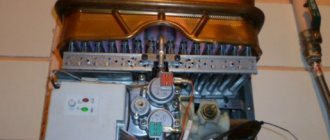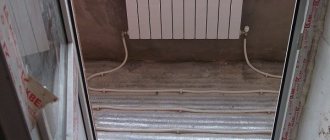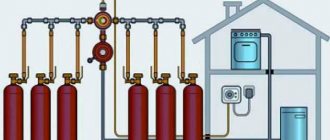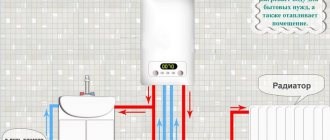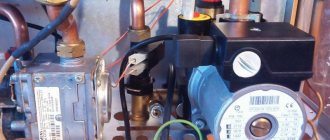Accompanying work when starting a gas boiler
Power is supplied, the heating regulator is set to the desired position.
The appearance of a hum indicates that the pump is starting to operate. Using a screwdriver, slightly unscrew the cap before water begins to leak out, then return the cap to its original position. This is done several times until the gurgling sounds disappear. The electric ignition of the boiler is triggered and it turns on. The pressure in the system is regulated by adding coolant. The system with circuits gradually heats up and enters operating mode. The effectiveness of the work depends on the accuracy of the preparatory stages.
Crimping
Pressure testing of heating pipes is carried out to identify possible leaks.
The procedure is carried out to detect leaks. Liquid or air is pumped into the system and a ten-minute break is taken, then the pressure gauge readings are checked. Constant values indicate the tightness of the circuits and connections.
Sometimes pressure testing is neglected, for example, due to the lack of a pump, but carelessness threatens to cut off the heat supply in the dead of winter. The procedure is repeated after the end of the heating season in preparation for the next one.
Washing
The process is intended to clean the system of debris. The taps on all radiators are opened, and containers are placed under them to collect water. A pressure of 4 bar is established in the system, the flow of liquid flushes the pipes and batteries from contaminants. In advanced cases, the procedure is performed several times.
There are 3 cleaning methods:
- Mechanical. Scale from the radiator is removed with a vacuum cleaner, scraper, or brush after soaking the elements in cleaning solutions.
- Chemical. Acidic solutions are pumped into the booster and driven for several hours. The method removes carbonate and ferrous deposits well.
- Hydrodynamic. Injecting liquid under pressure.
Construction of a Vaillant wall-mounted boiler (diagram)
- Combustion product collector
- Expansion tank
- Copper heat exchanger
- The combustion chamber
- Safety valve
- Automatic air vent
- Water pressure switch
- Circulation pump
- Return pipeline
- Make-up tap
- Cold water inlet filter + flow meter
- Water supply for the DHW circuit
- Water flow limiter
- Gas supply
- Gas valve
- DHW water outlet
- Water temperature sensor in the DHW system
- Heating system supply pipe
- Diverter valve
- DHW system heat exchanger
- Burner
- Ignition/tracking electrode
- Combined sensor
- Fan
- Closed chamber
Types and design of a gas boiler
The classification of boilers operating with gas is as follows:
- samples of floor and wall type. If we talk about convenience, then wall-mounted equipment, which is more typical for private buildings, would be more acceptable. The main advantage of a floor-standing unit is its much greater power, as a result of which it can be used to heat a room with a very significant area. Such models are very often used in production;
- gas boilers of atmospheric and turbocharged type. To understand how gas heating with an atmospheric boiler works, you can recall the principle of operation of a standard stove, where air from the room enters a specially designed chimney due to natural draft. Turbocharged devices are equipped with a fan, which is included in the design, and the fuel combustion chamber is completely closed, so all the required amount of air comes from the street (more: “How does a turbocharged gas boiler work - principle of operation, advantages and disadvantages”);
- mechanisms with one and two circuits. The design of a gas boiler with one circuit is designed so that this equipment is used exclusively for heating rooms, while devices with two circuits can also play an important role in the water supply system, providing the room with hot water;
- boilers equipped with a conventional burner or a modulating burner (for more details: “What are the types of gas burners for heating boilers - types, differences, rules of use”). In the second case, the power of the operating equipment is automatically regulated, due to which fuel costs can be significantly reduced;
Ignition and operating principle of pellet boilers
There are two ways to light pellet boilers equipped with volumetric burners:
- Using an electric fan heater, which creates a stream of hot air. This flow is directed to the pellets located in the burner. At this time, the boiler consumes about 1.2 kW from the electrical network (in general, the boiler consumes more than 0.3 kW for other operations).
- Manually (suitable for simple types of boilers). A special lighter fluid containing paraffins is poured directly onto the pellets in the burner. Then the granules with liquid are set on fire with matches.
When the boiler reaches the design mode values, the air inside heats up to 1200 degrees Celsius. Special holes on the surface of the burner are designed to supply fresh air using a fan. Upon reaching the operating temperature, the boiler operation stops: the air damper stops the air supply, and the drive of the auger intended for feeding granules is turned off. The boiler can remain in this state for up to 12 hours, since the burner maintains a very high temperature for a long time. But as soon as the batteries in the cottage become cooler, the boiler electronics themselves will start a new work cycle: they will turn on the auger and fan, and open the damper. Stainless steel is used to make the chimney of pellet boilers. At the bottom of the chimney there is always a special outlet pipe, which is used to remove condensate. If the chimney is properly mounted and installed, then about 5 liters of condensate accumulates in a week, but if you make an error in the installation, up to a bucket of water can accumulate every day.
All ash from the burner goes into the ash pan and from there, using a special auger, it is moved into the ash container. To increase the efficiency of the boiler, the smoke channels are cleaned of soot. Modern automatic pellet boilers are fully automated and these actions are also automated, the signal for them is an increase in the temperature of the exhaust gases. For simpler models, the kit includes a special brush for cleaning flue gas ducts.
In a torch-type burner, pellets are burned in an air flow created by a fan. Pellets that enter the combustion zone very quickly become coal and burn to form a flame with a temperature of about 1200 degrees Celsius. A stream of hot gases enters the convective part of the boiler, where the smoke pipes are located. There it transfers all its heat to the coolant entering the heating system, and after heat transfer it is discharged through the chimney. The ash goes into the ash pan automatically. For this, an electrically driven auger is used, as in a volumetric burner. You can remove the ash yourself using a special scoop, which is included with the boiler equipment. With this method of collecting ash, it is dumped into a separate ash storage box.
In gas generator boilers, the pellet hopper is built into the boiler body itself. At the bottom of the hopper there is an auger whose function is to lift the pellets to the cutter, which is a drum. From it, pellets fall in parts onto a ceramic radiator grill into the gasification chamber. Gradually, the fuel heats up and breaks down into oils, water vapor and resins. The subsequent reaction between oxygen from the air and carbon allows a temperature to be reached that is sufficient to form carbon monoxide (this is the most important component of the gas released). Oils and resins break down into hydrogen-containing gases. Next, the flammable gas enters the combustion chamber, which is located under the reactor. Here it burns, and the hot products formed during combustion enter the heat exchange part, where they are cooled and subsequently released into the chimney. A small amount of ash and those components of the pellets that do not burn remain inside. They must be removed regularly using special tools.
Starting the floor-standing unit
Preparations for starting a floor-standing boiler are carried out in the same way. The startup process itself goes like this:
- make sure that the power knob and temperature regulator are in the “Off” position;
- open the gas supply valve;
- turn the power knob to the “Ignition” position and press it. Hold the pressed position for several seconds (this is necessary so that the gas has time to displace the air accumulated in the tube), then press the “Piezo Ignition” button;
- release the control knob and make sure there is a torch on the pilot burner. If there is no torch, you need to try again, slightly increasing the holding time of the control knob in the pressed position;
- Set the coolant temperature adjustment knob to the desired position, after which the main burner will automatically start.
The first start-up of the gas boiler after installation must be carried out by service center specialists. If the consumer performs this procedure independently, he will not be able to obtain a warranty for the heating unit. However, the owners need to know how the boiler will start up, since shutdowns of the unit are possible during operation.
The process of igniting a gas boiler
When the preparatory activities are completed, they proceed to starting the gas unit. Manipulations for igniting a gas boiler depend on what type of ignition is installed on it: piezo or automatic.
Most modern gas boilers, for example, such as Beretta, Ferroli, Bosch, are equipped with automatic ignition and can be easily ignited by pressing one “Start” button. Before doing this, do not forget to turn on the unit to the electrical network and open the gas valve. Temperature adjustment is usually done using the “+” and “-” buttons. The unit does not always turn on instantly; sometimes you need to wait a few seconds for it to light up.
Piezo ignition is a little more difficult to implement: you will need to press the flame regulator and hold it for a while, and then activate the piezo button. Many domestically produced units are ignited in this way: ZhMZ, Lemax, AOGV, etc.
If a gas boiler is controlled using a remote control, then it always has a “Start” button, when pressed, the unit will ignite.
Note! Do not light a gas boiler if you smell gas in the room.
Possible problems
It happens that the boiler lights up, but quickly goes out. Before proceeding with the repeated ignition procedure, it is necessary to find out the reason that leads to the extinguishing of the burner. Most often, this happens:
- in the absence of normal draft in the chimney;
- insufficient gas supply pressure;
Modern boilers are equipped with a complex automation system, so the reason that the boiler lights up and then goes out is a malfunction of the automatic systems. So:
- If the burner goes out almost immediately after ignition, then you need to check whether the photocell installed on the flame sensor is covered with soot. To eliminate the malfunction, it is necessary to clean the sensor;
- if the sensor that controls the gas draft in the chimney fails, the boiler cannot be started, the automation will block the gas supply;
- The reason for shutting off the gas supply may be a faulty thermocouple or a failed sensor that controls the coolant pressure.
Modern heating units are equipped with a liquid crystal display, which displays an error code when a malfunction occurs. Explanation of error codes can be found in the technical data sheet of the equipment.
If no information is displayed on the display, then the cause of this malfunction is most likely a blown fuse or an incorrect connection to the electrical part of the boiler.
The first start-up of a newly installed gas boiler should be carried out by a specialist performing commissioning work. If the first start-up is carried out by the consumer independently, then it will not be possible to issue a warranty for the heating equipment, so you should not neglect the need to call a specialist from the service center. In the future, it will be possible to ignite the unit after stops without the involvement of professionals. But first you need to study the instructions and strictly follow the instructions given in it.
Features of turning on a gas boiler
How to turn on a gas boiler? When starting, follow the rules specified in the passport and take into account the operating features listed below.
How to start a gas boiler? We list the main most important features:
Particular attention should be paid to the fact that it is recommended to fill the coolant at positive room temperatures. Otherwise, traffic jams may form.
Therefore, carefully check what the temperature is in the rooms and house, whether there are frozen sections of pipelines in winter. We start the boiler itself strictly according to the instructions, maintaining the required amount of time while holding the start button, otherwise it may not start. For different models, the passports always describe in detail the startup procedure. Be especially careful when working with gas equipment, as this is a very dangerous type of fuel, characterized by a low odor and a high explosion hazard. Do not neglect safety measures when working with the device, do not violate the procedure for working with it. At the slightest deviation from normal operation, immediately carry out measures to repair and adjust the equipment, including calling a specialized technician. Observe the requirements for the installation of the boiler room and ventilation. Your safety in the house directly depends on this.
To summarize, we can say that a gas heating system is currently one of the most popular devices from autonomous heating sources. The economic component is always of interest to the common man. Utility costs take up a significant part of the family budget. The growth of tariffs, with annual indexation, leads to a gradual increase in the level of prices for services to the population.
The consumer tries to find any opportunity to reduce these costs. The cost of natural gas is currently low compared to other energy resources. Therefore, it is profitable to gasify houses and install a heating system that runs on gas. Even if you have to spend a lot of money on it during construction, installation and commissioning, it always pays off later.
How to remove air locks
Diagram of the correct location of the boiler and chimney.
Simply connecting the system by filling it with water is not enough. It will not work or its effectiveness will become extremely low. To carry out a full first start-up of the equipment, it is necessary to bleed all the air that has accumulated in it from the system. A modern gas boiler may have a special system for automatically releasing air when filling, but the efficiency of such systems is low. This means that manual bleeding of the main and other systems is required during connection. Only after this can you start.
Removing air pockets during connection is carried out not only in the circulation pump, boiler, but also in all heating radiators. In this case, it is recommended to start the process with radiators. Especially for this purpose, they are equipped with so-called Mayevsky taps, which you simply need to open by placing a basin under them. At first, a slight whistle will be heard - this is the air gradually leaving the system. If the plugs are removed, water begins to flow. If the batteries are free of air masses, then the taps must be closed. This simple procedure is carried out with each radiator; it must be checked and cleared of plugs. When air has been removed from all radiators, the pressure gauge needle will be set to the desired value. Before turning on the gas boiler, you need to add coolant to the system, that is, feed it with liquid.
Next, you need to completely remove all air pockets from the circulation pump, which requires disassembling some parts of the boiler. This work is simple, you just need to remove the front panel of the boiler, and then find a cylindrical part that has a lid in the middle of the body, it has a slot for a screwdriver. The boiler must be started, that is, power must be supplied, and the heating regulator must be set to the required operating position. After this, a faint hum will be heard - this will start the circulation pump. You can hear gurgling and other sounds. Using a screwdriver, you need to slightly unscrew the lid of the found part; this should be done until water flows out. As soon as the liquid begins to seep out, the lid must be screwed back on. This procedure needs to be carried out 2-3 times, after which the air pockets will completely leave the system, the sounds and gurgling will disappear, and the pump will begin to operate quietly. Immediately after this, the electrical ignition of the equipment will work, and the gas boiler will begin to operate independently.
The pressure in the heating system must be equalized by adding water to the required level. The system gradually warms up and begins to enter normal operating mode. Connection and first start-up for any heating equipment is a complex and demanding process. How effective the heating will be depends on proper preparation, startup, and adjustment of the system.
Removing air pockets
Boilers may have an automated air removal system, but often it does not work fully. Therefore, it is better to bleed the air manually. This is necessary for the boiler to operate smoothly.
Air must be bleed from the circulation pump, the equipment itself and from all radiators of the heating system. Start with the last one. Drain the water from them into a basin by opening the Mayevsky taps. The release of air from the system will be accompanied by a slight whistle. As soon as water flows, the plugs are removed. You can close the taps.
Mayevsky's tap prevents water from leaving the heating system
After cleaning all radiators, the pressure will drop. It needs to be raised to normal.
The next step is to remove air from the circulation pump. To do this, you need to disassemble several parts of the boiler.
- Remove the front panel of the boiler.
- Inside, find a cylindrical part with a cover with a slot for a screwdriver.
- Start the boiler and set the heating regulator to the desired operating position. You will hear a faint hum - the circulation pump has started working. Sometimes this process is accompanied by gurgling and other sounds.
- Remove the cover from the cylindrical part using a screwdriver.
- As soon as water starts leaking, screw the lid back into place.
- Repeat this 2-3 times. After this, extraneous sounds should disappear and the pump will function silently.
After all the procedures have been correctly completed, you can light the boiler and it will start operating in normal mode. Equalize the pressure to the desired level again to ensure the boiler operates correctly.
The first start-up of heating equipment is a simple process, but it must be taken seriously and responsibly. Don't ignore the rules. The entire operation of the heating system will depend on their exact execution.
Construction of a BAXI wall-mounted boiler (diagram)
- Fan
- Primary heat exchanger
- Overheat thermostat
- Heating circuit temperature sensor
- Gas valve
- Secondary plate heat exchanger
- Three way valve motor
- Three way valve with bypass valve
- Minimum pressure switch
- DHW temperature sensor
- DHW flow sensor
- Pneumatic relay (traction sensor)
- Ignition electrode
- Flame control electrode
- Gas-burner
- Gas train with nozzles
- Expansion tank
- Pump with automatic air vent
- Drain tap
- Safety valve
- Fill tap
- Pressure gauge
- Heating system input
- DHW output
- Gas supply
- Cold water inlet
- Return from heating system
Peculiarities
In order to turn on a gas boiler, you need to know its structure well, as well as its system features.
The first step is to consider the design of a standard AGV.
- Boiler equipped with an autonomous gas heater. This is a tank that is located in a casing.
- The pipe that is inside this tank. Gas combustion occurs in it, due to which the water is heated. The combustion products that are formed inside come out through the chimney.
- Heating devices. For example, hot water flows into the heating circuit. Then it circulates through all the pipes. When the water cools, it is sent back to be warmed up. All this is a closed gravity heating system.
- An expansion tank that is installed on top, above the gas boiler. It allows water, which expands when heated, to rise to the top.
- Pump. It is located behind the gas boiler, which allows you to efficiently pump water through the entire system. The speed of coolant movement throughout the system can be increased or decreased. All these processes are controlled using automation.
Such heating devices have both disadvantages and advantages.
Among the advantages, the following points can be noted.
- AGVs are safe and reliable in operation, completely independent of electricity, and have the ability to install automatic locking.
- They consist of different types of water heaters. This includes both floor and wall structures.
- Such units are quite simple, easy to repair and maintain.
- They are not very expensive, and besides, such models are very economical.
Portable and stationary igniters for gas boilers
It was already mentioned above that according to the type of installation, portable and stationary igniters are distinguished. Let's take a closer look.
Ignition electrode block for Viessmann gas boiler
Portable. Such devices are connected to the gas pipeline using rubber-fabric hoses. It is necessary to have a rope on the gas pipeline fitting and the igniter (to tighten the end of the hose). It is necessary to install a shut-off valve on the gas pipeline up to the hose. To carry the ignition device into the firebox, there must be a hole in the lining masonry with a diameter of d > 50 mm.
For fireboxes with a maximum vacuum of 8 kgf/m², single-flame igniters with medium or low pressure are suitable. Here, the gas boiler igniter device is a burner with partial air injection. Gas is removed from the nozzle, thereby sucking air through the holes in the injector structure. The resulting mixture of gas and air moves through the mixer and is removed from the fire nozzle into a protective casing with a flange. This is where the gas starts to burn. With a change in pressure and gas composition in the igniter, only the diameter of the nozzle needs to be changed. If there is excess pressure in the firebox, then the igniter must produce a fully prepared mixture of air and gas, which is obtained at medium gas pressure in the injection, and at low pressure - in the igniter with forced air supply.
You can read about burners for gas boilers here.
Stationary. Such devices have an increased level of safety and easy ignition of the main burner. The torch must be stable, no matter what the operating mode of the boiler, it must ignite the mixture of air and burner gas well, and be easily ignited with a portable igniter or electrical appliance.
Pilot Burner Sit
This igniter can:
- be a separate block of a gas burner or part of it;
- be single-flare or multi-flare;
- start from the main burner or operate on a permanent basis;
- be set on fire electrically or at a distance.
A stationary igniter involves supplying gas from the gas pipeline to the shut-off devices of the main burner.
Pressure testing and washing
Pressure testing of the system is not the most necessary preparatory stage, but it is desirable, since it will show defects and leaks in advance, if any.
Pressure testing is not always done due to the lack of a special pump and the reluctance to call a team, but if the heating fails in the midst of cold weather, the costs can be much higher!
It is especially important to check a new system and one that, on the contrary, has been in use for several years. The cost of crimping in construction companies is from 3000 rubles
Additionally, they may charge a fee for visiting the site (about 2 thousand rubles). By the way, a manual pressure testing pump will cost 4.5 – 6 thousand rubles
The cost of crimping in construction companies is from 3,000 rubles. Additionally, they may charge a fee for visiting the site (about 2 thousand rubles). By the way, a manual pressure testing pump will cost 4.5 – 6 thousand rubles.
Classification
There are a huge number of types of this equipment, which allows you to choose the one that suits you in all respects.
Table: types of gas boilers
| Number of circuits | By traction method | By ignition type | By installation method | By power modulation | |||||
| Single circuit: heating only | Double-circuit: heating and hot water supply | Natural traction | Ventilation draft | Electronic ignition | Piezo ignition | Floor-standing | Wall mounted | Single stage | Two-stage |
The gas boiler can be located on the floor and wall
Floor-standing boilers differ from wall-mounted boilers in a wide range of power adjustments. With this equipment you can heat a room of 200 m2. If you connect a boiler to it, you can also provide yourself with hot water.
A wall-mounted gas boiler will fit perfectly into any interior
A single-circuit boiler can heat one thing: either the coolant, or the heating system, or the hot water supply. When using a dual-circuit system, you can simultaneously connect space heating and hot water supply.
Boilers with natural draft are distinguished by the fact that combustion products are removed using constant inflows of street air. They are often used to heat non-residential premises and small houses. In boilers with ventilation draft it is forced. In them, combustion occurs in a closed chamber. The special chimney is equipped with external and internal pipes through which air is drawn in. They do not burn room oxygen and do not require additional air flow to support combustion.
In the room where the gas boiler is located, the ventilation system should be well thought out
For equipment with an electronic igniter, the switching process is automated. Such models are more economical than boilers with piezo ignition, since they do not have a special part with a constantly burning flame. If the power supply is interrupted, the equipment stops functioning, but automatically resumes operation when power returns.
Boilers are also classified according to energy efficiency:
- condensation;
- convection
The latter do not form condensate, which can dissolve acids located on the walls of the device. But the heat transfer in it is lower.
Types of igniters
An igniter for a gas boiler is an indispensable device in the design of a gas unit, the functions of which include igniting the main burners and adjusting the flame.
The table shows all kinds of igniters for a gas boiler, distinguished by installation method, air supply principle, operating conditions, depending on the type of ignition, and the presence of different functions.
| Criterion | View |
| By installation method | – portable; – stationary. |
| Depending on the ignition type | – manual (which are ignited by a burning match, paper, tourniquet, etc.); – electric (which are ignited by a spark and a red-hot coil). |
| Based on the air supply principle | – with an active air environment; – with forced air supply; – diffusion; – injection. |
| By availability of functions | – with flare control; – without flare control. |
| According to operating conditions | – igniters for furnaces with vacuum, – igniters for furnaces with supercharging. |
Why does the pilot light of a gas boiler go out?
Accompanying work when starting a gas boiler
The first start involves pressure testing and flushing the system. Many specialists bypass this stage, but it is still recommended not to abandon it. In order to carry out all further operations, it will be necessary to use a pressure pump. The system is tested to determine the strength and tightness of all components and connections of the system. During pressure testing, the system is checked for leaks. Pressure testing can be done with a water column or compressed air. To do this, pump water under pressure equal to one and a half times the operating pressure, after which the system must remain at rest for 15 minutes. Then the operating pressure should be restored. If the pressure gauge shows a decrease in pressure during pressure testing, this means that a leak has formed somewhere. Defects should be eliminated by repeating the crimping process.
Next, you should start flushing the system; this is considered an indispensable process that should accompany the first start-up of the unit. Initially, a rough flush should be performed, which will remove light suspended matter. The washing process must be carried out at a pressure of 4 bar. Finish washing will be the second stage, for which injection pumps should be used. There is a possibility that the filters, which are installed directly in front of the boiler, will become clogged. If this happens, you should close the shut-off valve and clean the filter after disassembling it.
Possible breakdowns of a gas boiler
There is such a problem: after you release the start button, the igniter goes out. This malfunction is associated with a breakdown of the gas boiler automation system. But under no circumstances should you use the boiler with the automation switched off. This is due to the fact that if the flame goes out due to a strong air flow or if the gas supply is unexpectedly stopped, the gas supply may begin to flow into the room.
Thus, the igniter flame begins to come into contact with the thermocouple. The thermocouple heats up in 30-40 s, and an emf appears at its terminals. It is enough to trigger the electromagnet. Thus, the rod is fixed in the lower position. After this, you can release the start button.
The draft sensor is located in the upper part of the gas boiler, next to the pipe for discharging combustion products into the environment. Such a device consists of a contact and a bimetallic plate.
If a pipe becomes clogged, its temperature rises sharply. The bimetallic plate begins to heat up and the voltage supply circuit to the electromagnet breaks. Thus, the stem cannot be held by the electromagnet and the valve closes. This means the gas supply will stop.
Piezo ignition of a gas boiler
Gas boiler automation unit with piezo ignition.
Piezo ignition acts similar to the piezoelectric element in lighters. In boiler equipment, to activate this element, a special button is used on the body of the gas boiler. Pressing the button by the user of the equipment causes a spark to occur and starts the gas combustion process.
Piezo ignition button for Beretta boiler.
In fact, the ignition method is semi-automatic. This is not a machine gun yet, but you don’t even have to bring a match to the burner. What is good about piezo ignition?
Firstly, a simple design. You can try to repair a failed unit yourself, or replace the old gas boiler ignition unit with a new one, which will not cost much.
Secondly, piezo ignition is an analog element that does not require electricity for the operation process. If you do not have electricity on your site, starting the boiler using piezo ignition is carried out without problems. Plus, boiler equipment with piezo ignition is cheaper for objective reasons, although not by much.
Commissioning of a floor-standing boiler
Introductory information
Automation EuroSit 630 is a multifunctional device that regulates the gas supply. It provides the ability to regulate the temperature and completely turn off the main burner.
Purpose:
- automatic adjustment of gas supply;
- control of the safety of gas equipment.
It is worth noting the difficult method of turning on the device. In his defense, we can say that in this way the manufacturer was concerned about the safety of its consumer and the safety of gas equipment.
Start of a gas boiler
The operation of a gas boiler begins with the start of the automation. In the situation of using the 630 EuroSit valve, the startup process will consist of several stages. They should be performed in accordance with the established order:
- turning on the tap on the riser;
- turning on the pilot burner;
- turning on the main burner;
- temperature adjustment and setting.
Step-by-step description of the startup procedure
The first step is to turn on the gas supply to the system. To do this, you need to open the tap on the riser.
Now you can start working on the gas valve. To do this, you need to concentrate on the control handle of the device. Initially, it is located in the “off” position. It must be moved to the “ignition” position (image of fire on the regulator). After this, you need to press the handle so that the forced supply of gas to the pilot (ignition) burner begins. Now you should press the piezo ignition button while continuing to hold the handle pressed. The presence of a flame on the pilot burner indicates that everything was done correctly. The handle should be kept pressed for the next ten seconds after pressing and while checking for the presence of flame. This must be done to start the gas boiler mechanism.
After ten seconds, you need to release the control handle and check again for the presence of a flame on the pilot burner. If there is no flame on the burner, then all the operations described above should be repeated. In this case, you will have to increase the time you press the control handle.
If there is a flame on the pilot burner, then you can proceed to ignite the main burner. To do this, the control handle must be moved to position from “1” to “2”, turning it counterclockwise. The correctness of the actions will be indicated by the appearance of a flame from the main burner. After making sure that it is present, the control handle can be moved to positions from “1” to “7”. The position must be selected based on the coolant temperature needed to be obtained. In the situation with the EuroSit 630 model, the number 7 on the handle corresponds to a temperature of 90 degrees. This is the maximum possible value for the model. By following all these steps, starting the gas boiler will go without problems.
Disabling a device
To turn off the gas boiler, you must turn off the gas valve. There are two shutdown options:
- turning off the main burner;
- turning off the main and pilot burners.
In the first case, the control handle must be turned clockwise and set in the “ignition” position. The main burner will then be switched off, but the pilot burner will continue to operate.
In the second case, the same control knob must be turned clockwise until the “off” position is reached. These actions will stop supplying gas to all burners. A click will sound to confirm that the device is turned off. The flame will also disappear. The gas supply has now been stopped.
Ignition of the gas burner of boiler No. 1.
Page 6 of 20 Immediately before ignition, turn on the smoke exhauster and fan and blow through the firebox and chimneys for 10-15 minutes. Ending; ventilation of the firebox and chimneys is determined by taking a sample for the presence of gas with a gas analyzer in the upper part of the combustion space and at the mouth of the burner.
Before turning on the smoke exhauster, you must manually rotate the exhauster shaft and make sure that the impeller does not touch the housing. They check gas and air pressure and vacuum in the combustion chamber using instruments.
The value of these parameters must correspond to the data in the mode card.
After completing the above operations, you can start igniting the boiler.
Open the K-4 tap and ignite the gas in the charger, warm it up for 2-3 minutes, achieving stable combustion.
Bringing the charger to the burner embrasure and smoothly opening the G-12 valve, ignite the burner, simultaneously starting the air supply.
Regulate the vacuum. Increasing the thermal load of the burner occurs as follows: first add gas, then air (reducing the thermal load of the burner occurs in the reverse order: first reduce the air supply, then gas and regulate the vacuum). If during ignition there is a separation of the flame from the heating pad, then it is necessary to immediately close the G-12, ventilate the firebox for 10-15 minutes, take a sample to determine the absence of gas in the combustion space and, having previously found out the cause of the separation, repeat the ignition.
If ignition has occurred successfully, the burner torch burns steadily, the flame is orange, then in this case the K-3 tap on the SB-1 safety plug is closed and the igniter is removed from the ignition hole and turned off.
Next, you need to couple the P3K hammer with the rocker arm and turn on the boiler protection (automatic safety system), make an entry in the shift log about the date and time of firing the boiler.
Emergency shutdown of boilers and furnaces using protection. The gas supply to the installation must be immediately stopped by the action of protections when: - the burner flame goes out; — unacceptable increase or decrease in gas pressure before
Preparatory stage
Before starting the heating unit, it is necessary to carry out a number of preparatory work, including:
- filling the heating circuit;
- eliminating air jams;
- additional check of equipment serviceability.
Filling the system
If a modern gas boiler is installed, then the process of filling the heating system circuits is not particularly difficult. For this purpose, a special pipe is used, to which the coolant supply is supplied. After opening the tap, the circuits will begin to fill with water.
The condition of the heating system is monitored by special devices - pressure gauges. The readings of these devices allow you to monitor the operating pressure in the system. After the pressure gauge shows a pressure value of 1.5-2.0 atmospheres, you will need to stop the coolant supply.
Removing air
The presence of air pockets does not allow the coolant to circulate freely in the system. Many models of modern boilers are equipped with a device that allows you to automatically release air trapped in the system.
But often the operation of such devices is not efficient enough. Therefore, experts recommend venting air from radiators and the circulation pump. To remove air pockets from radiators, the latter are equipped with Mayevsky taps. To remove the blockage, you must:
- place any container under the tap;
- open the tap;
- bleed the air until water begins to flow;
- Close the tap.
This procedure must be done with each heating radiator.
A more complex operation is to bleed air from the circulation pump; for this you need to:
- remove the lid from the boiler;
- find where the pump is installed, it looks like a cylinder with a cover with a slot;
- put the boiler into operation (how to do this will be described below);
- when the unit is turned on, the circulation pump will also begin to operate;
- if this unit is air-filled (and this usually happens if the first start-up is carried out after filling the system with water), it will make gurgling sounds during operation;
- Using a screwdriver, you need to carefully begin to unscrew the lid with the slot;
- first, air will begin to come out from under the lid, and after the water flows, you need to screw the lid back;
- if the gurgling sounds do not stop, then you need to repeat the operation;
- after the air lock is eliminated, the pump will operate quietly and the boiler will go into operating mode.
additional verification
Before starting the unit, you must:
- make sure that the gas pipeline is sealed, that is, the meter does not record gas consumption when the gas valve on the unit is closed;
- check whether the automation system works, turning off the boiler in the event of an emergency;
- check for traction.
If at least one of the above conditions is not met, the launch cannot be performed.
How to light a Dani boiler
Open the tap on the gas pipeline in front of the device (boiler).
2. Turn the control knob all the way (counterclockwise) to the ignition position and press down, hold it pressed for 5-10 s (the holding time that is necessary to displace air from the pilot burner tube), and turn further, without releasing the knob, to the middle position (there should be a click). If the pilot burner lights up, you must hold the control knob pressed for at least 15 seconds and release it smoothly. Then turn the control knob to the position (the device (boiler) is on) to ignite the burner, while the flame on the pilot burner should not go out.
3. The pilot burner may not ignite until gas pressure forces the air out of the pilot tube. If the flame goes out, repeat the operation after at least 1 minute. If for any reason the burner does not light up and the pilot burner goes out, re-ignite it no earlier than after 5 minutes.
4. The temperature of the coolant in the apparatus (boiler) is regulated by turning the temperature control knob to position 1-7. Position 7 approximately corresponds to a temperature of 90° C.
Drawing. Gas valve “HONEYWELL”
The sequence of turning on the device (boiler) with a gas valveEUROSIT
Drawing. Gas valve "EUROSIT"
1. Open the door of the device (boiler). Make sure that the temperature control and adjustment knob (control knob) is in the position (appliance (boiler) off). Open the tap on the gas pipeline in front of the device.
2. Turn the control knob counterclockwise to the piezo ignition position.
3. Press the control knob all the way and, without releasing it, press the piezo ignition button until it clicks. keep the control knob pressed for 5-10 seconds.
4. Release the control knob and check the presence of flame on the ignition (pilot) burner
5. If there is no flame, repeat the steps, increasing the time you press the control knob.
6. The temperature of the coolant in the apparatus (boiler) is regulated by turning the control knob to position 1-7. Position 7 approximately corresponds to a temperature of 90°C.
The sequence of switching on the device (boiler) with the gas valve "ZAO Mashzavod"
ATTENTION! Before igniting the apparatus (boiler), check that the main burner tap is closed
1. Open the door of the apparatus (boiler) and, making sure that valve 3 in front of the burner is closed, open the valve on the gas pipeline in front of the apparatus (boiler).
2. Press the start button 1 all the way and, while holding it, press the piezo ignition button 2 until it clicks. The pilot burner may not ignite until the air is forced out of the pilot burner tube by gas pressure. In this case, press the piezo ignition button several times without releasing button 1 until the pilot burner is completely ignited.
3. After 30 seconds (counting from the moment the flame appears on the pilot burner), release the start button, while the flame on the pilot burner should not go out. If the flame goes out, repeat the operation, no earlier than after 5 minutes.
Drawing. Gas valve JSC "Mashzavod"
4. Open burner tap 3 by smoothly turning the tap handle 90° counterclockwise (the tap handle should be parallel to the gas pipe). The main burner should light up. If for any reason the burner does not light up and the pilot burner goes out, then it is necessary to close the burner valve 3 and repeat the operations again, but not earlier than after 5 minutes.
5. Turn the temperature adjustment knob 4 to set the required heating temperature of the coolant in the apparatus (boiler). Control heating using temperature indicator 1. The temperature of the coolant in the apparatus (boiler) is regulated by turning the control knob to position A to E. Position E approximately corresponds to a temperature of 90ºC of the coolant in the capacitive heat exchanger. Mark 5, corresponding to the set temperature position on the temperature adjustment knob, must coincide with mark 6 on the gas valve body.
Thank you, warmth to everyone.
Preparatory stage
As a rule, in warm weather the heat supply structure is not used. Therefore, before starting heating in a private house, it is necessary to ensure the integrity and reliability of its elements and carry out a number of preparatory work. Before using a closed heating system, you need to determine the amount of deviation of its actual indicators from the calculated parameters.
According to the rules, preparation for the heating season is carried out in a certain sequence. First of all, a visual inspection of communications and heating equipment is carried out. For the property owner, the first question should not be how to put the radiator into operation. First of all, he needs to make sure that there is no mechanical damage to the device body and check the reliability of its connection to the pipeline.
Also, before starting the heating system, a number of preventive measures are carried out:
- Checking the condition of the smoke exhaust system. To start a boiler, there must be sufficient draft force in the chimney to maintain combustion. For this reason, the internal cavities are cleaned of soot and the integrity of the pipe is inspected. In a brick structure, if necessary, replace damaged elements. Rust, if any, is removed from galvanized pipes.
- Visual inspection of pipes. Without this, running the heating system is dangerous. You need to find out how tight the pipes are and whether there are any cracks or noticeable defects.
- Battery condition monitoring. Before starting heating in an apartment building, the management company must warn residents about this, and they must check the integrity of the radiators. You cannot disconnect individual devices from the heating network. When filling the pipelines, make sure there are no coolant leaks.
This is a list of rules without which the first start-up of the system should not be done. In order for the heating season to start correctly, a number of measures must be taken. A test run of the heating system in an apartment building is carried out 1–2 months before heating starts. It is best for property owners to stay home during this time to ensure there are no leaks.
How the Lemax boiler works and how it works
The location of Lemax's enterprises is the Russian city of Taganrog. The supply of main components for boiler equipment assembled at our own facilities is carried out by both Western and domestic partners. The production of the heat exchanger and housing is mainly carried out by Russian enterprises, while control units, automation and burners come from abroad.
Boilers of this type can be equipped with both open and closed combustion chambers. There are always pressure and temperature regulators on the body of the units. As a rule, you can turn on a Lemax boiler not only from the mains: some models do not depend on electrical energy at all. According to safety regulations, a Lemax device must always be connected to a chimney. Only rooms with good ventilation are suitable for installing the equipment.
A characteristic feature of Taganrog devices is the simplicity of the procedure for lighting a Lemax boiler. Regardless of how many circuits this equipment serves, and what kind of material was used for its manufacture, connecting it to the electrical network usually does not cause any particular difficulties. A prerequisite is the use in the circuit of how to turn on a Lemax gas boiler, a voltage stabilizer (any surge can cause a breakdown of the device).
The Lemax boiler consists of the following components:
- Gas burner.
- valves.
- Control boards.
- Expansion tank.
- Circulation pump.
